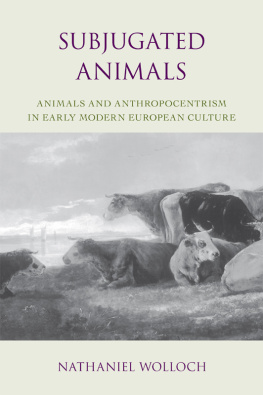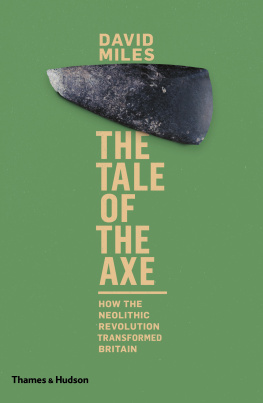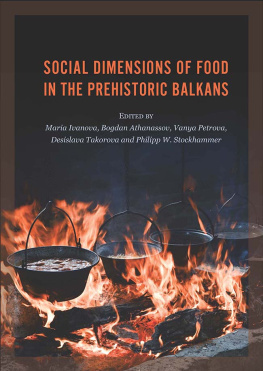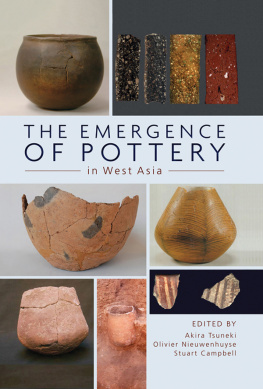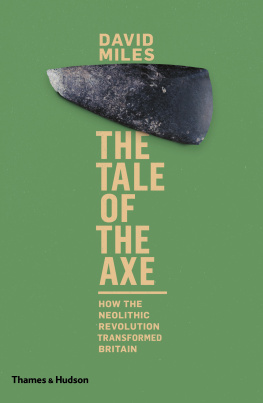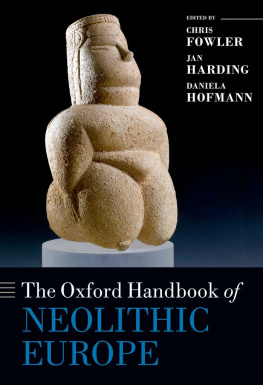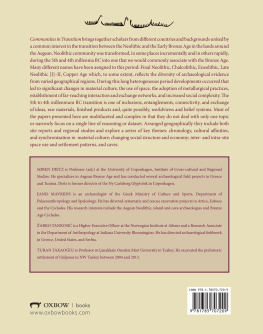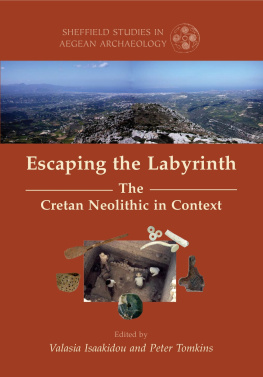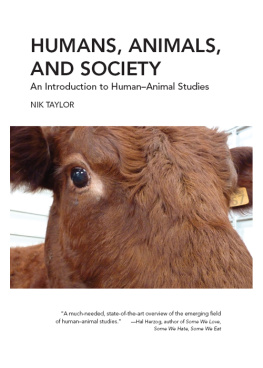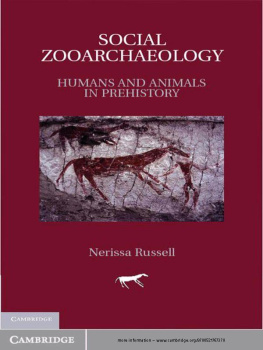Placing Animals in the Neolithic
Placing Animals in the Neolithic
Social Zooarchaeology of Prehistoric Farming Communities
Arkadiusz Marciniak
First published 2005 by UCL Press
Published 2016 by Routledge
2 Park Square, Milton Park, Abingdon, Oxon OX14 4RN
711 Third Avenue, New York, NY 10017, USA
Routledge is an imprint of the Taylor & Francis Group, an informa business
Marciniak, Arkadiusz 2005
All rights reserved. No part of this book may be reprinted or reproduced or utilised in any form or by any electronic, mechanical, or other means, now known or hereafter invented, including photocopying and recording, or in any information storage or retrieval system, without permission in writing from the publishers.
Notice:
Product or corporate names may be trademarks or registered trademarks, and are used only for identification and explanation without intent to infringe.
You must not circulate this book in any other binding or cover and you must impose the same condition on any acquirer.
British Library Cataloguing in Publication Data
Marciniak, Arkadiusz
Placing animals in the Neolithic: social zooarchaeology of prehistoric farming communities (Institute of Archaeology)
1 Prehistoric peoples Food Europe, Central
2 Agriculture, Prehistoric Europe, Central
3 Neolithic period Europe, Central
4 Domestic animals Europe, Central History to 1500
5 Animal remains (Archaeology) Europe, Central
6 Human-animal relationships Europe, Central History to 1500
I Title II University of London. Institute of Archaeology
338.19409012
Library of Congress Cataloguing in Publication Data
Data available
ISBN 13: 978-1-59874-212-1 (hbk)
Typeset by Phoenix Photosetting, Chatham, Kent
For Kasia, Zuzia and Maja
This book has been a long time in the making. It has grown out of my intertwined interests in archaeological theory and archaeological sciences on the one hand and the humanistic and social versus the biological aspects of archaeological enquiry on the other. The idea of the book began to crystallise during my Fulbright fellowship at the University of California at Santa Cruz. Subsequently, I wrote a large share of the book during my research stay at Stanford University.
I am indebted to many people whom I cannot list in full. First of all, I wish to express my heartfelt gratitude to my mentor, Janusz Piontek. His impact upon my scientific career has been immense. I am very thankful to him for hours of discussion, inspiration and continuous support.
I am especially grateful to those who generously opened their archives and collections, thereby giving me access to the necessary data, especially unpublished material. I am particularly pleased to express my debt to Lech Czerniak, who has not only made it possible to analyse material from newly excavated settlements in Kujavia but has also constantly inspired me with his thorough knowledge of the Early Neolithic in Central Europe. I am grateful to Aleksander Koko for giving me an opportunity to study archive materials from some Neolithic sites from Kujavia and for his unflagging encouragement and interest in my work. My sincere thanks go to Janusz Kruk, who kindly let me study materials from Bronocice and led me through the vast archives and materials from this significant settlement. I would also like to thank Anna Kulczycka-Leciejewiczowa for allowing me to study the then-unpublished materials from Zawara. My thanks also go to Barbara Burchard for giving me access to materials from the Niedwied settlement and for our thought-provoking discussions. I am also grateful to Wojciech Brzeziski for making possible the study of materials from Kamie ukawski. In addition, I would like to thank Bogdan Balcer for his help in analysing material from the mielw settlement. Danuta Makowicz-Poliszot kindly assisted me as I struggled with a number of unpublished faunal reports from the Maopolska region. Thanks are also in order for Marzena Makowiecka and Daniel Makowiecki for giving me access to unpublished faunal reports of Kujavian assemblages. I would further like to express my thanks to Halina Dobrzaska and Sawomir Kadrow for their help and hospitality while I worked in Krakw.
I would further like to acknowledge the profound intellectual and stimulating influence of several of my colleagues. Ian Hodder has always been a source of great inspiration for me. Discussions with him on various occasions have been both extremely stimulating and challenging. I appreciate his detailed comments on an earlier draft of the book. In terms of theoretical perspective, the book also owes much to my regular discussions with Diane Gifford-Gonzalez and Judith Habicht-Mauche during my stay in Santa Cruz. I am also grateful to Diane for her zooarchaeological training and our many stimulating discussions. My thanks also go to her and Jorge Martinez Moreno for their input on the taphonomic part of the book. I am particularly grateful to Danuta Minta-Tworzowska, my boss, for her constant support and encouragement. I would like to express my deep gratitude to Peter J Ucko for taking an interest in the book and for leading it through the editorial process at UCL Press as well as for his continuous help.
Large parts of the manuscript were read by John Chapman and Laszlo Bartosiewicz, whose comments helped me to clarify my arguments and improve on certain aspects. I appreciate their time and efforts very much indeed. My thanks also go to Michael Shanks for reading and commenting on parts of the manuscript. I am also indebted to Peter F Biehl, Janusz Czebreszuk, Chris Gosden, Cornelius Holtorf, Alicja Lasota-Moskalewska, Preston Miracle, Marzena Szmyt and Wodzimierz Rczkowski for discussing with me various issues tackled in the book. I would like to thank two anonymous reviewers for detailed comments and a number of inspiring remarks that helped me to better structure the arguments presented in the book. Construction of the complex database would not have been possible without the support of my brother Jacek and Maciej Lison, to whom I am deeply grateful. I also appreciate the support of Waldemar Woyski, who advised me on the application of the statistical part of the analysis. Special thanks go to Maja for professional assistance in preparing the tables. I would also like to thank my many other colleagues too many to name here for the discussions and inspirations that shaped various ideas manifested in the book.
Last but not least, I would like to express my deep gratitude to my wife Kasia for the years of patience, endurance, and encouragement and to my daughters Zuzia and Maja for placing all my undertaking in perspective and for making my life truly rewarding and enjoyable. I also owe much to my parents, who are a source of strength and support for me.
Contents
This is the first study in which an innovative approach to animal bone assemblages from prehistoric agricultural sites called interpretive social zooarchaeology has been employed. Until now, zooarchaeology has been characterised by a dearth of interpretive thinking (but see Hesse 1995), with most authors favouring established approaches to faunal remains. Accordingly, despite notable methodological and taphonomic advances in the field over recent years, zooarchaeological analyses tend to be formulaic affairs that rarely enter the mainstream dialogue of theoretical archaeology.
The most recent methodological developments, however, concern the zooarchaeology of hunter-gatherers. Processual explanations of sociocultural change often bring in economic and ecological factors (ie Crabtree 1990; Driver 1990). Indeed, a great deal of zooarchaeology practised in the cultural-historical tradition is characterised by astonishing simplicity, and this is particularly true of Europe. This attitude is striking, considering that faunal remains are following pottery the class of archaeological data most commonly recovered from prehistoric farming settlement sites. In both traditions, the study of faunal remains has been more concerned with methodologies than with social theories to examine the dynamics of past societies. The Central European tradition of faunal studies is a theory-free discipline aimed at analysing and describing animal economic exploitation by prehistoric groups. The work of faunal specialists is assumed to provide accurate determinations of prehistoric husbandry and environmental conditions, with the prevalence and importance of wild and domesticated species calculated on the basis of their nutritional (hence utilitarian) value.


